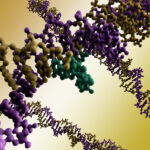
In the ever-expanding landscape of genomic data, scientists face a monumental challenge: how to interpret vast datasets profiling thousands of individual cells with the nuance necessary to unravel biological complexity and disease mechanisms. Amidst this data deluge, a new computational breakthrough, CellWalker2, developed by researchers at the Gladstone Institutes, promises to transform how cell types are classified and compared across experiments, tissue types, and even species. This innovation, recently published in Cell Genomics, leverages hierarchical relationships between cell types to build a more robust, interconnected understanding of cellular identity and function, pushing the boundaries of multi-omics data integration.
Our biological world is composed of myriad cell types that work in concert, each distinguished by unique genomic and epigenomic signatures. However, defining these cell types precisely has remained a stubborn problem. Traditionally, researchers tried to assign cell identities based on discrete labels derived from single datasets, but this approach falls short when confronted with the diverse criteria employed by different laboratories and technological platforms. CellWalker2 addresses this issue by recognizing that cell types exist within a hierarchical framework—some cells are close kin, while others reside on distant branches of the cellular tree. By embracing this concept of hierarchy, the tool aligns cell types more naturally, akin to sorting puzzle pieces first by color and then by pattern, ensuring more accurate data interpretation.
One of the foundational inspirations behind CellWalker2 is the intrinsic relationship among cell types that often goes unexploited by other computational methods. For instance, immature and mature neurons can appear deceptively distinct, though they share close developmental kinship. Unlike flat clustering approaches that treat each cell label as unrelated, CellWalker2 models these nuanced biological relationships, thereby refining the classification process and enhancing the biological relevance of cell type assignments. This innovation is crucial for integrating datasets generated in varying experimental contexts, where conventional cell labels might not translate seamlessly.
Single-cell ATAC-seq, a relatively recent technique focusing on chromatin accessibility, offers high-resolution glimpses into the regulatory landscapes that govern cell identity and function. While incredibly informative, ATAC-seq data are notoriously noisy and difficult to interpret. CellWalker2 builds upon earlier work, including the original CellWalker algorithm, by not only integrating single-cell ATAC-seq with RNA sequencing data but by extending this integration to multi-omic profiles. This allows it to connect regulatory elements in DNA to the specific genes and pathways active in distinct cell types, shining light on the regulatory logic underpinning cellular diversity and disease pathology.
The technical backbone of CellWalker2 involves constructing a statistical map where cell types from disparate datasets are linked through one-to-one matches or broader hierarchical relationships. This approach accounts for discrepancies in cell labeling conventions and experimental conditions, rendering cross-study comparisons more reliable. By quantifying the strength of relationships between cell types, the tool transcends simplistic matching strategies, offering researchers a detailed landscape in which to explore cellular biology. This facilitates discovery not just of known cell types but of transitional states and potentially novel subpopulations that might be pivotal in health and disease.
The implications of CellWalker2 stretch beyond mere categorization. By mapping regulatory DNA regions active in specific cell types and revealing the transcription factors likely orchestrating gene expression changes, the tool unlocks a deeper understanding of cellular function and malfunction. This is especially relevant in complex diseases such as autism, schizophrenia, and congenital heart defects, where understanding the regulatory “switches” that operate within particular cells can provide clues to disease mechanisms and therapeutic targets.
One remarkable demonstration of the tool’s versatility was its application in comparing immune cells from different studies, generated using varied experimental methodologies and analyses. Despite these technical differences, CellWalker2 successfully harmonized the data, uncovering both precise matches and broader relationships among immune cell types. This capability holds promise for easing long-standing bottlenecks in immunology research, where integrating data from multiple cohorts and technologies is often fraught with inconsistencies.
Furthermore, Pollard and her team applied CellWalker2 to investigate brain cells across species, including humans, marmosets, and mice. The hierarchical mapping revealed which cell types are evolutionarily conserved and which are uniquely human, offering invaluable insights into brain evolution and the cellular underpinnings of cognitive complexity. Such cross-species comparisons are fundamental for advancing translational neuroscience and refining animal models of human neurological diseases.
Importantly, the developers have made CellWalker2 open source, providing extensive documentation and examples designed to support researchers with varying computational expertise. This accessibility promises to democratize advanced multi-omic analysis, enabling broad adoption across the biomedical community. The tool’s ability to link disparate data types through meaningful biological relationships marks a significant step forward for systems biology.
By accurately translating raw genomic and epigenomic data into interpretable cellular landscapes, CellWalker2 lays vital groundwork for next-generation diagnostics and personalized treatments. As the complexity of biological data grows, tools that embrace the inherent hierarchies and relationships between cells will be indispensable. According to Dr. Katie Pollard, this platform facilitates connecting disease-associated genetic variants to the regulatory programs and cell types they influence, thereby bridging the gap between genotype and phenotype.
In summary, CellWalker2 redefines how we integrate and interpret multi-omic data by combining hierarchical modeling with multi-layered biological insights. Its ability to reconcile cellular identities across contexts, methodologies, and species heralds a new era in computational biology. As research continues to uncover the intricate networks orchestrating life at the cellular level, tools like CellWalker2 will be at the forefront of translating complexity into clarity, unlocking pathways toward novel interventions for a wide array of diseases.
Subject of Research: Multi-omic integration and hierarchical modeling of cell type relationships to improve cross-study and cross-species analysis of single-cell genomic and epigenomic data.
Article Title: CellWalker2: Multi-omic discovery using hierarchical cell type relationships
News Publication Date: 22-May-2025
Web References:
Article DOI: 10.1016/j.xgen.2025.100886
Gladstone Institutes: https://gladstone.org/
References:
Hu, Z., Pollard, K., & Przytycki, P. (2025). CellWalker2: multi-omic discovery using hierarchical cell type relationships. Cell Genomics. https://www.cell.com/cell-genomics/fulltext/S2666-979X(25)00142-9
Image Credits: Michael Short/Gladstone Institutes
Keywords: Computational biology, Single cell sequencing, Comparative analysis, Cell models, Sequence analysis
Tags: advancements in genomic data analysisbiological complexity and disease mechanismsCellWalker2 for cell classificationchallenges in defining cell identitiesepigenomic signatures in cell typesgenomic data interpretationGladstone Institutes research innovationhierarchical relationships in cell typesinnovative computational tools in biologymulti-omics data integrationtransforming cell data analysisunderstanding cellular identity and function



